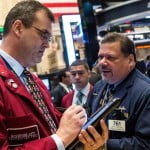High-yield exchange-traded funds have become a hot story in the last few days, with many market participants wondering what the effect might mean on the broader market.
To get right to the point, here’s the correlation between the overall stock market and high-yield bonds. To be specific, this is a chart of the rolling three-month correlation between the S&P 500 and the Barclays U.S. Corporate High Yield Bond Index.
As you can see, over the past five years, the correlation has almost always been positive. Even though they are still technically “bonds,”junk bonds reflect a higher-risk portion of the spectrum, and hence trade more similarly to stocks. These certainly aren’t as safe as government Treasury bonds — and they definitely don’t trade like them.
Read MoreWhat the scare in the junk bond market means for regular investors
The average correlation over this entire time period is around 35 percent. But we’ve seen it swing widely, from a high of 68 percent to a low of negative 22 percent. Right now, we are experiencing correlations in the 40s — so just slightly higher than usual.
While there exists a chance this could spread, what we are more likely witnessing in the high-yield market is a natural, albeit dramatic, resetting that could end up realigning things in a healthy way down the road.
For now, the high-yield problems haven’t come to affect broader equities in a meaningful way.
[“source -cncb”]





